Mobility
Sustainability
How green are electric scooters? New insights on the environmental impact of shared e-scooters
October 15, 2021
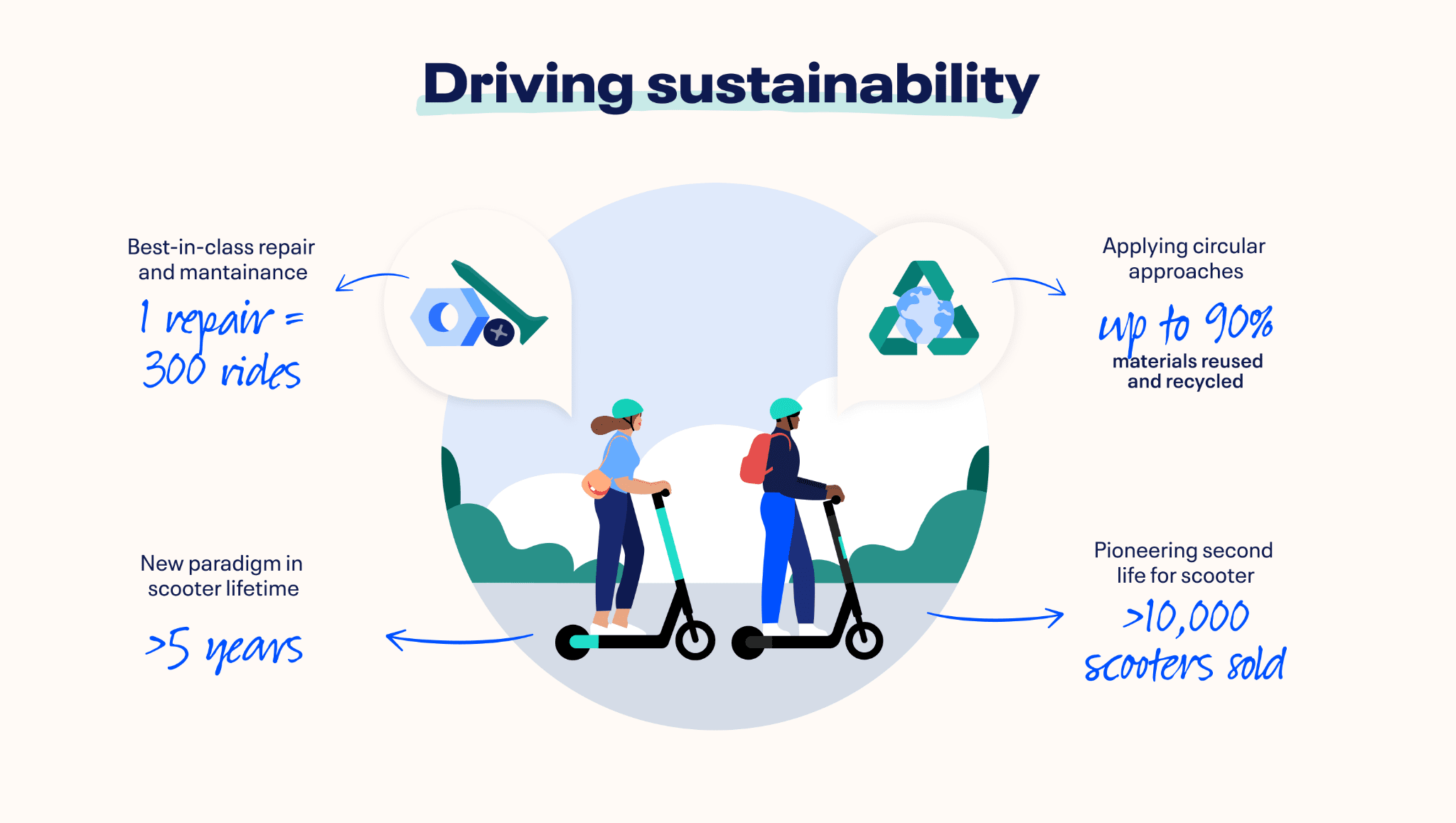
The recent 6th Assessment Report of the UN Intergovernmental Panel on Climate Change provided the latest scientific evidence to what some of us have known for a while. That 1) climate change is progressing far more quickly than was anticipated and 2) we need to drastically reduce emissions across all sectors to reach global net zero emissions by 2050.
Fossil fuel combustion for transport purposes is a key driver of greenhouse gas emissions (GHG), accounting for 24% of GHG emissions globally (IEA, 2020). Addressing the climate crisis by decarbonising urban transport through replacing cars with the smaller, cleaner mode of shared, electric micro-mobility is what shaped our mission and inspires our work at TIER every day.
How can e-scooters reduce emissions in the transport sector?
One of the best ways to look at this is via the perspective of lifecycle environmental performance in carbon dioxide emissions per passenger kilometer travelled (gCO2/pkm). This reflects the total emissions impact that a vehicle has over the course of its lifetime, including the embedded carbon emissions from manufacture, through to emissions that accrue from logistics and transport, fuel, and emissions from servicing operations.
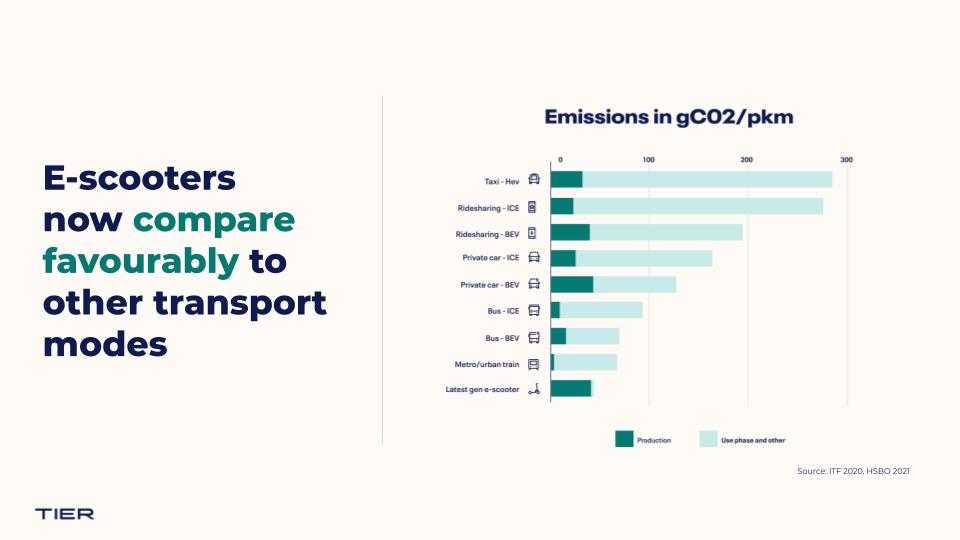
Our latest e-scooter, the TIER V - complemented by our green operations model that uses swappable batteries, green energy to charge the batteries, and electric operations fleet - only emits 42.8 gCO2/pkm (HSBO, 2021). This is over 70% less than what a private car emits (see Figure 1) (ITF, 2020). If the additional lifespan enabled through the reuse of our vehicles were to be included, the emissions impact per passenger km would be even lower.
How did we get to this point?
Over the past 2-3 years, we have invested and innovated to improve the design of our e-scooters for greater durability, modularity and repairability - and continue to do so. The result is a tailor-made, long-lasting vehicle to be shared and loved by more people and more cities. Due to the improved design as well as our industry-leading maintenance and repair process, our latest generation e-scooters can now last over 5 years. Through this improved design, we were able to reduce emissions by over 60% in just two years (Figure 2).
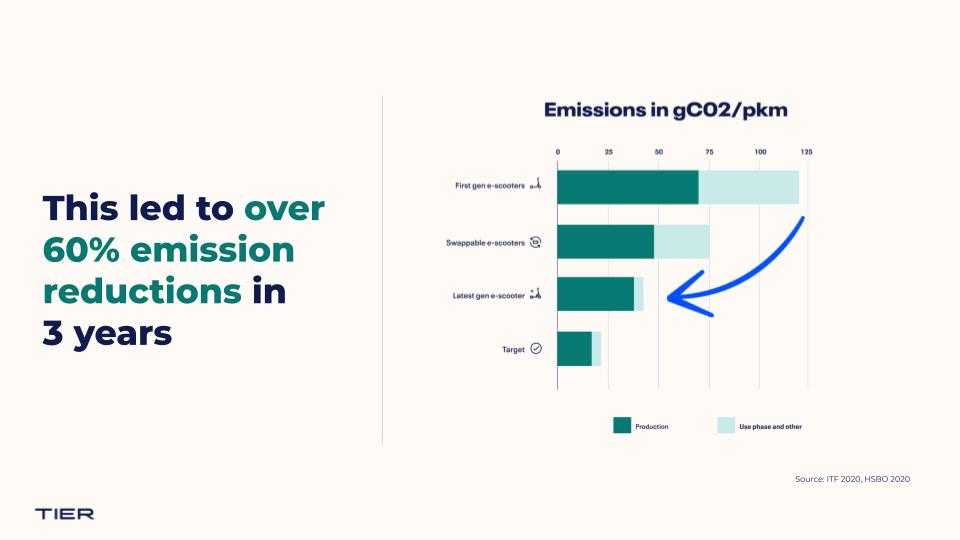
The International Transport Forum (ITF) estimated the first generation of e-scooters to emit 121gCO2/pkm, based on a lifespan of 6 months and the use of diesel vans in servicing operations (ITF, 2020). Over the course of 2019 and 2020, our change from e-scooters with non-swappable to swappable batteries has led to significant further reductions of our footprint to 76gCO2/pkm (Severengiz et al., 2020). Further improvements in lifespan and switching to green energy and electric operations fleets mean that our latest generation of e-scooters are not even outdone by the low emissions of public transport and indeed can be effective enablers of existing public transport networks.
In fact, a recent mobility habit survey we conducted shows that 25% of our riders regularly use our service as a first/last mile solution in combination with public transport, while 50% do it occasionally. Our data also shows that close to 50% of TIER rides start or end within 100m of a public transport station - another sign that many trips are used as part of intermodal journeys.
What remains to be done?
E-scooters are clearly a sustainable option in the urban transport mix and, by replacing car use as well as complementing public transport networks, they can contribute to the decarbonisation of urban transport. Indeed, the ITF projects that active mobility, micro-mobility and shared mobility need to take up close to 60% of the urban transport mix by 2050 to increase sustainability and resilience of the transport system (ITF, 2021).
We already see a significant share of riders using our service to replace car rides and for intermodal trips that connect with public transport options. Our latest Citizen Research project, where we surveyed over 8,000 people across different cities, shows that on average 17.3% of our rides already replace car rides, with the share being as high as 22% in cities such as Berlin (illustrated by chart below).
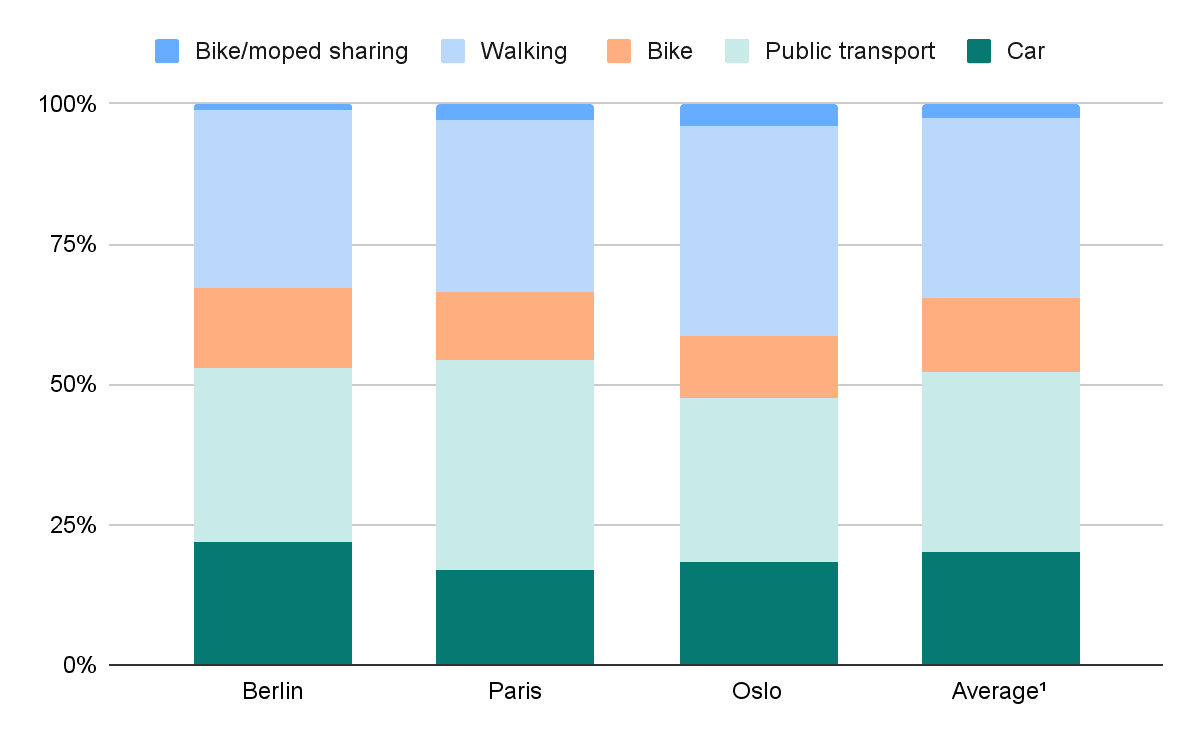
This means that since the founding of TIER we have replaced over 12 million car rides, which led to over 5 million kgCO2 emissions avoided. In addition to the emissions impact, the replacement of car rides also brings other benefits, such as harmful air pollutants and noise pollution avoided, which greatly impact the health of urban citizens.
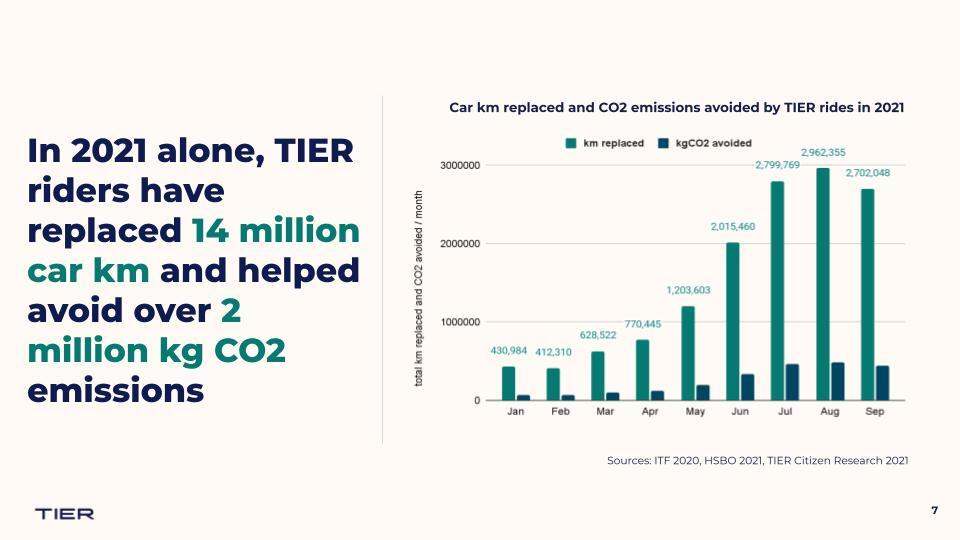
This is just a start. At TIER, we are committed to further growing the share of car rides replaced and public transport journeys enabled with e-scooters but also increasingly with new modes such as e-bikes - though we cannot do that alone. It also demands investment in micro-mobility infrastructure, developing more and deeper integrations with Mobility as a Service (MaaS) platforms, and extending bundled service and pricing models with our partners.
Beyond changing the landscape of urban transport options, we continue to drive sustainability standards in our industry. By increasing the use of recycled aluminium in production, improving design and operations to prolong lifetime even further we aim to cut emissions at least by half to around 20gCO2/pkm as illustrated in Figure 2 above.
Just a few years into our journey (TIER is not yet 3), we have demonstrated that, when done right, shared micro-mobility can truly be a sustainable transport option and contribute to the decarbonisation of urban transport. While there is always room to do better, our actions since TIER’s founding have shown that as a company we are committed to changing mobility for good. We are already eagerly working on the improvements outlined above and can’t wait to unlock yet more of micro-mobility’s sustainability potential.
(1) Notes: BEV = battery electric vehicle; ICE = internal combustion engine; sources: latest generation e-scooter (Severengiz et al., 2021), all other data (ITF, 2020)
(2) Sources: first generation e-scooter scenario (ITF, 2020), swappable e-scooter scenario (Severengiz et al., 2020), latest generation e-scooter scenario (Severengiz et al., 2021)
References
Severengiz, S. Finke, N. Schelte and N. Wendt (2020), Life Cycle Assessment on the Mobility Service E-Scooter Sharing, 1-6, 10.1109/E-TEMS46250.2020.9111817.
Severengiz, S. Finke, N. Schelte and J. Schünemann (2021), Life Cycle Assessment of the TIER Mobility scooter sharing systems using the scooter model ES400C
IEA (2020), Tracking Transport 2020, IEA, Paris, https://www.iea.org/reports/tracking-transport-2020
IPCC (2021), Climate Change 2021: The Physical Science Basis. Contribution of Working Group I to the Sixth Assessment Report of the Intergovernmental Panel on Climate Change [Masson-Delmotte, V., P. Zhai, A. Pirani, S. L. Connors, C. Péan, S. Berger, N. Caud, Y. Chen, L. Goldfarb, M. I. Gomis, M. Huang, K. Leitzell, E. Lonnoy, J. B. R. Matthews, T. K. Maycock, T. Waterfield, O. Yelekçi, R. Yu and B. Zhou (eds.)]. Cambridge University Press. In Press.
ITF (2020), Good to Go? Assessing the Environmental Performance of New Mobility, OECD Publishing, Paris, https://www.itf-oecd.org/sites/default/files/docs/environmental-performance-new-mobility.pdf
ITF (2021), ITF Transport Outlook 2021, OECD Publishing, Paris, https://doi.org/10.1787/16826a30-en.